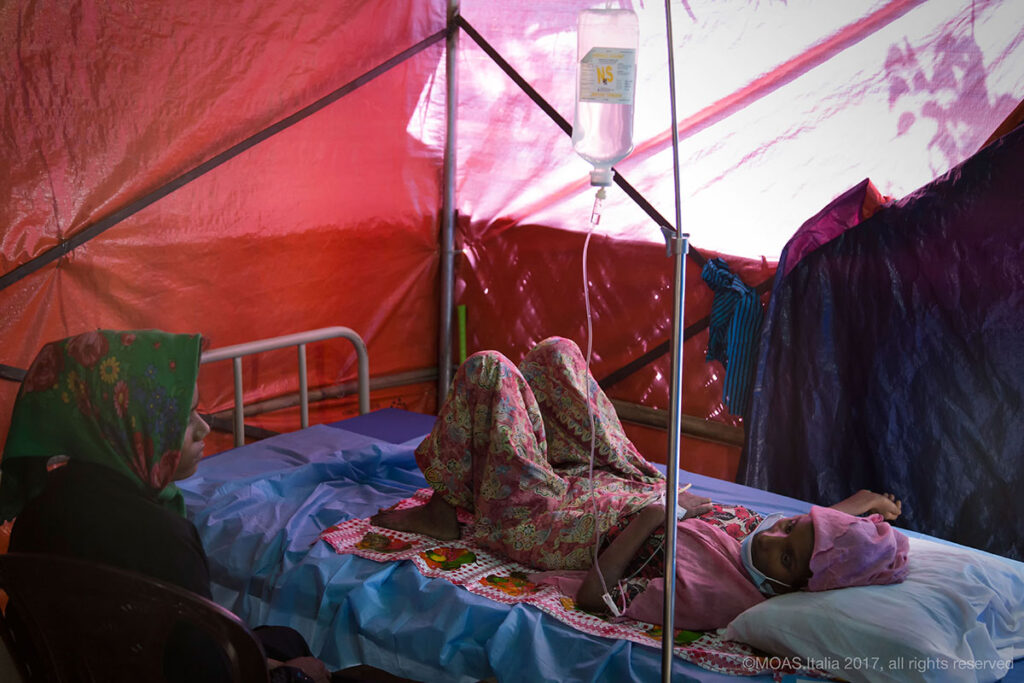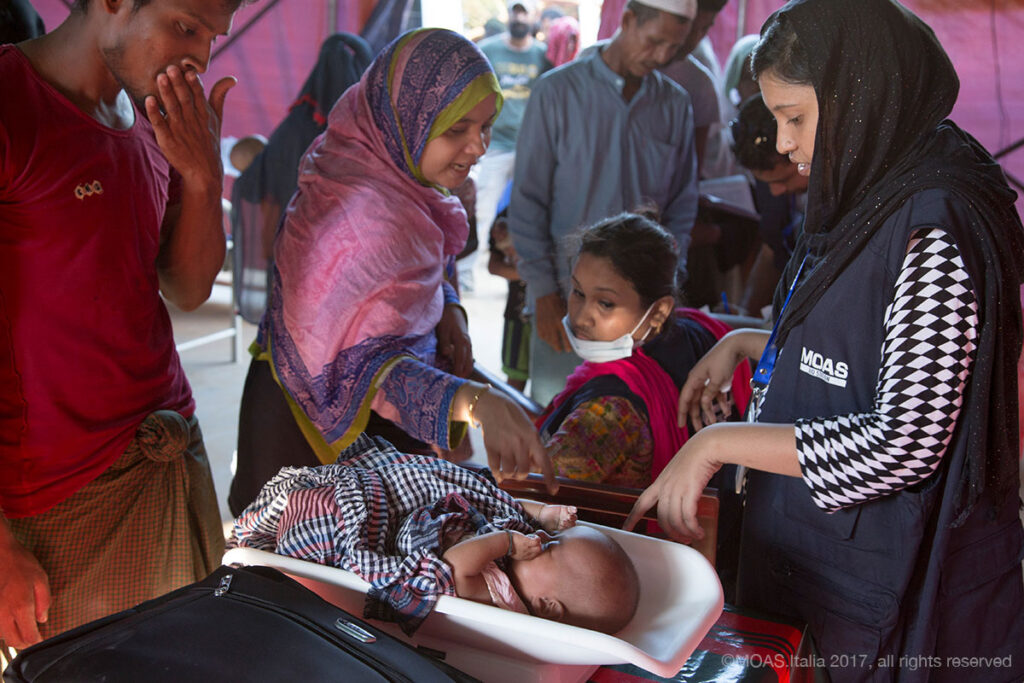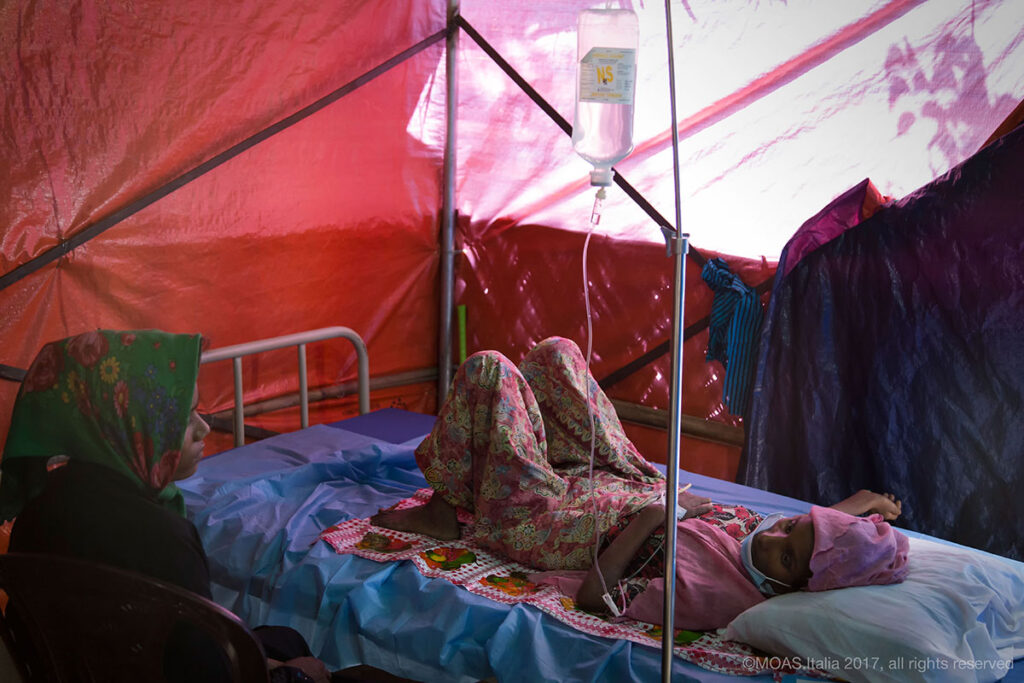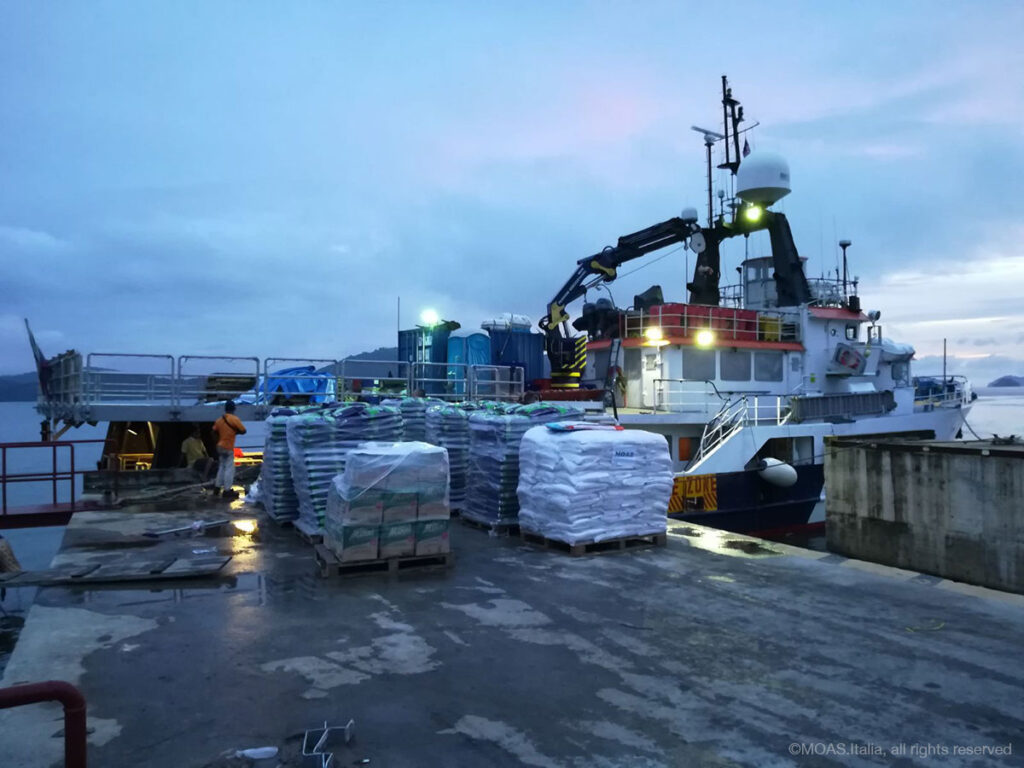Hello and welcome to MOAS…
Last time you joined us we were exploring the sudden influx of Rohingya refugees into Bangladesh and their conditions living in makeshift shelters.
This time we’re looking at MOAS’ operations in Bangladesh, from its Aid Stations to the deliveries provided by the Phoenix. There are two MOAS Aid Stations now operating in Bangladesh, one near the fishing village of Shamlapur and the other which recently opened at Unchiprang.
They’re field hospitals providing primary and secondary medical care to local Bangladeshis and Rohingya in nearby camps. Each Aid Station is broken down into a clinic, waiting area, pharmacy and two tents. Staffing them are a diverse team of doctors, pharmacists and cultural mediators.
When we have a patient come into our facility they first go to the waiting room and they are registered and given a card with a serial number. Their number is called and they then go to the triage area. In the triage their blood pressure, temperature and weight is taken and then they go to the doctors in the outdoor department.
They then receive treatment and prescribed medication. We have a separate room for emergency cases where we can provide nebulization, hypodermic injections and oxygen.
Those who arrive in an emergency go directly to the emergency section where we have doctors and medical assistants who are capable of taking care of the emergency cases. They can handle bandages, stitches and stop bleeding. We also administer the recommended injections from the outdoor section there.
At the beginning we give patients medicine for three days. After three days, we provide more medication if they need it.
In a situation and location where resources are spread thinly, MOAS aims to fill the gap.
My Son’s name is Saiful Islam and he’s three months old now. I’m glad that he’s got medicine. I’m 20 years old and I feel happy to have medicine too.
I’m 20 years old and I’m here because I can’t eat and I feel light headed. I also have a fever and that’s why I’m here. I now have medicine, so I feel really glad.
Up to 300 people can be seen by the Aid Stations every day, and these are some of the people who’ve used their services.
But while the teams provide dedicated care on the ground, the Phoenix is also playing a role. The Phoenix crew are collecting aid and delivering it to Bangladesh.
Timothy Tunley, is from the Mission to Seafarers Chaplain and he’s currently on board the Phoenix supporting the crew. He told us a little about his life on board the Phoenix and how the crew are taking on their new roles.
I am here because MOAS invited Mission to Seafarers to send Chaplains out to the Mediterranean when you were rescuing refugees there, and I was the first person to put my name forward. And then, as the mission has changed, so then my place on the vessel has remained the same.
What’s it like being on board?
It is very challenging. I’ve been working for Mission to Seafarers for 8 years – I must have probably visited 6000 ships – but it’s only when you start to live on a vessel with other people that you realize how demanding life on board can be. Just very simple straightforward things, like getting your washing done, making sure you’ve got clean clothes, being the only person from your country on board, and making friends culturally across boundaries as well.
What’s your daily routine?
I get up at 7.30 and have breakfast with the crew and check all my own admin which takes about an hour, all my emails and bits and pieces. Then I am available for the crew if people are going ashore, and if jobs need to be done I’ll accompany the crew if there’s fetching and carrying to do. In the afternoon I’m much the same.
But in the evenings I try and spend time with the crew for pastoral support to find out how they are. During the day I make a point of being on the bridge for each part of the watch, and during the afternoon I make sure I’m in the engineering workshop to be with the engineers. Today I went to the bank with the captain and we collected some bits and pieces for the vessel, some technical pieces and some paint and some engine bits and pieces which needed doing as well. At Bangladesh I worked on the door to help security while we were unloading.
Can you tell more about what you saw, smelt and felt about working in South East Asia?
The amazing thing about Bangladesh was simply the heat, it was just incredibly hot and then the unloading. I’m used to working on gantries where you have to avoid the very large cranes and guys were just picking up bags of rice and dal and putting them on their heads and unloading the vessel in that way, and that was a real eye-opener: the difference between a first world and a developing country’s port system. That made quite a deep impression on me.
Langkawi is where we are picking up the aid – we’re waiting for a cargo at the moment – and it’s breathtakingly beautiful. The other big impression made on me in Bangladesh was talking to Bangladeshi Navy guys. I was on the deck until quite late watching for security and the guys came up and started talking and sharing their lives in Bangladesh and that was a real privilege, a real unexpected privilege.
How is the crew taking the change of mission?
Well interestingly, I think it must be very different from picking up refugees all the time, where now we’re picking up tonnes of relief and moving it around back to Bangladesh. The other evening we had a barbeque and I sat down with the crew and took advantage of the fact we were together. I said, “Tell me about what it was like in the Mediterranean”. One of them said “Oh no, I don’t want to talk about that,” and then talked for 15 minutes about rescuing refugees, and the other crew all joined in as well. I’d been onboard for 5 and a half weeks at that point, and it felt like the most important moment of all. This was the crystallization of why I had come, to be with them, to hear their stories. All the religious stuff to one side, the most powerful thing we can do is to share our stories with other people.
What would you say are your takeaways from your time with the crew of the Phoenix?
Well first a great sense of thankfulness for this opportunity. No-one, as far as I know in our organization, has ever been to sea as a chaplain for two months. I have a great sense of admiration for the work MOAS do, the coordination effort to get everything done is huge, and a personal admiration for the seafarers I’m working with who are away from home for a long period of time, who are in contact with home through Skype and all the rest of it but are actually physically away from their homes in Malta and the Philippines. The crew here is an impressive bunch.
There is also the privilege of being here in Malaysia; we’ve been here for just over a week and the chance to see the crew in action both at work and at play has made quite a deep impression on me as well…. Also one day I had sun stroke which put me in bed for 36 hours, and on the way over from Bangladesh I was out of action with sea sickness for three days as well, so that made a deep impression on me as well.
The Phoenix is on route to Chittagong in Bangladesh from Langkawi Malaysia carrying 20 tonnes of humanitarian aid. They should arrive on the 18th of November, marking their second aid delivery since MOAS started operating there.
So now you have an idea of what MOAS is doing in Bangladesh and how the process is joined up with the Phoenix. If you liked this podcast don’t forget to hit like, comment and subscribe for more podcasts from us.
Check out our latest updates on Facebook, Twitter, Instagram, Youtube and AudioBoom… or you can donate to help us provide urgent medical assistance to Rohingya refugees.
From all of us here at MOAS: goodbye.





